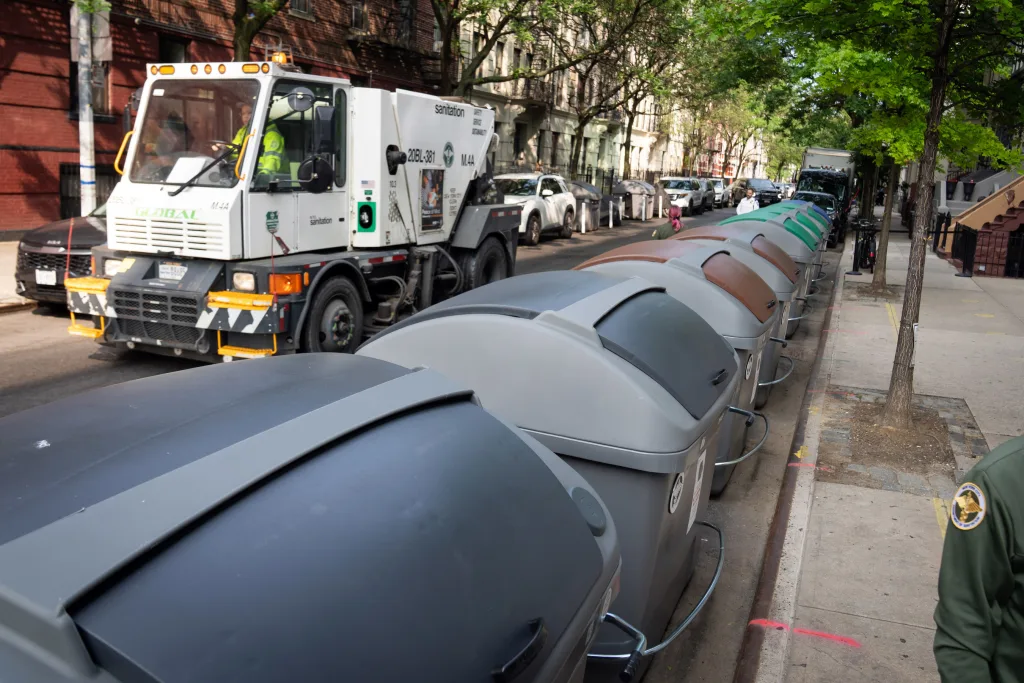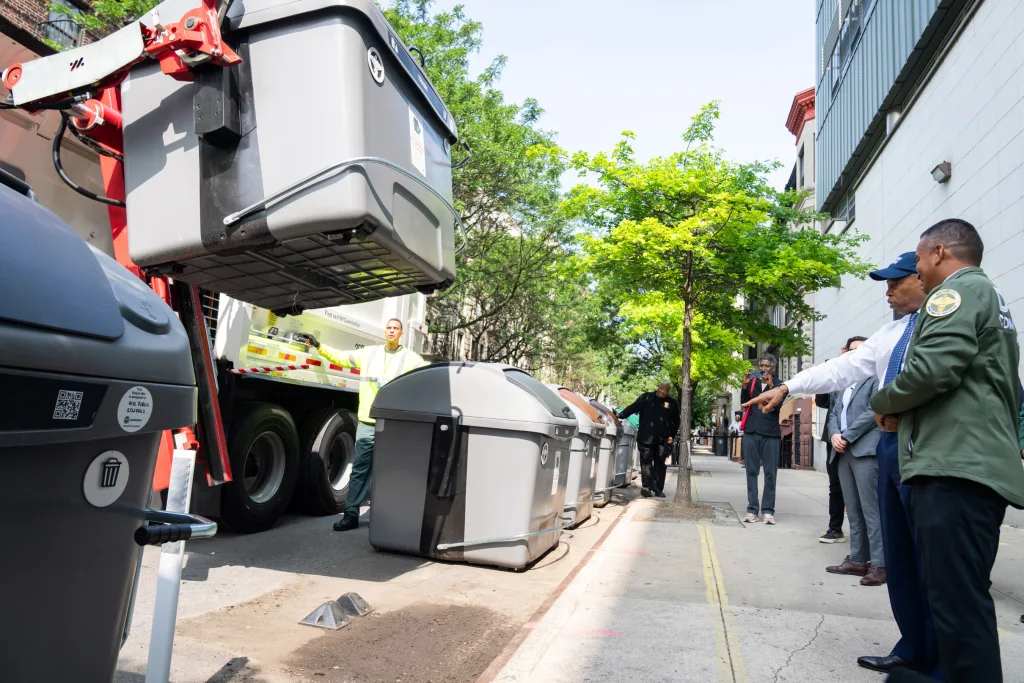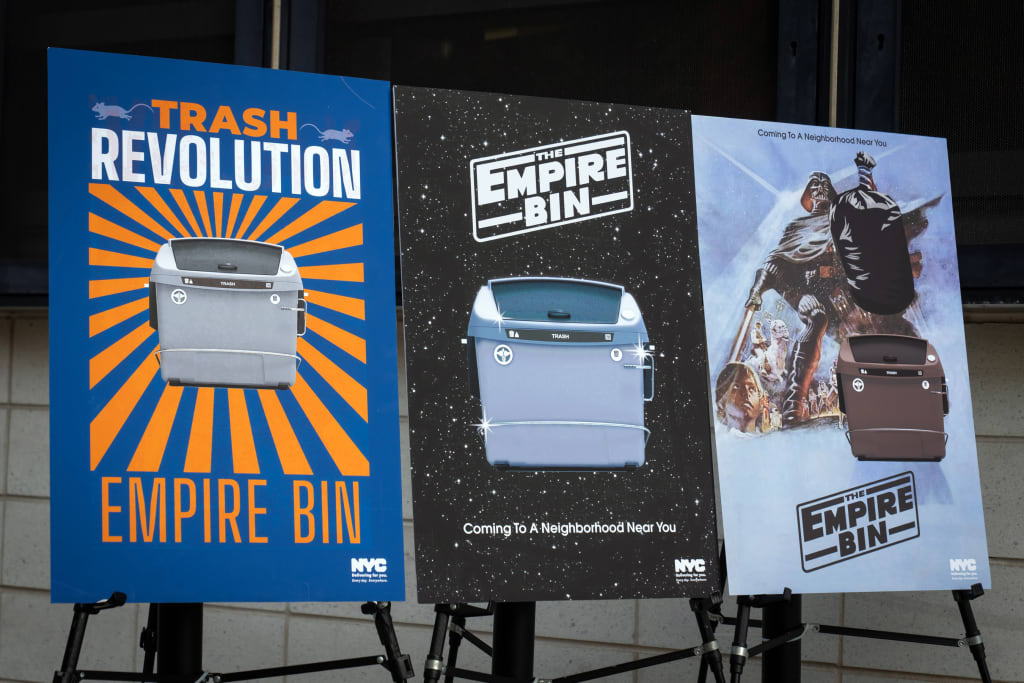
In late June, I was standing at an intersection in the New York City neighborhood of Harlem, at 5 a.m., surveying a row of hulking gray bins that lined the curb. Next to me, Joshua Goodman, the deputy commissioner for Public Affairs & Customer Experience at DSNY, admired his team’s handiwork.
“We want it to be iconic, but we also kind of want it to blend in and disappear,” Goodman said of the bin. “Eventually we want you to walk down the street and not notice that it’s here.”
As the sun rose, and sleepy commuters passed by us, he explained that while these new bins are novel today, the hope is they become just another part of the streetscape. This morning, however, the European-style bins are hard to miss.
Standing 3-feet wide and 5-feet tall with gently curved lids, these stationary on-street containers, officially named Empire Bins, are parked in front of large apartment buildings in Manhattan’s Community Board 9. They are the latest initiative from New York City to fight rats and keep the streets clean, after the city commissioned a $4 million McKinsey study that concluded that the future of trash management is cans and bins.
Since the study, restaurants and residential buildings between one and nine units have had to dispose of their waste in city-sanctioned trash cans (55 gallons or less, with a secure lid), in lieu of the heaping mounds of black trash bags that used to line the streets. Then, this past April, the city unveiled the Empire Bins as the next phase of its experiment in corralling waste.
These sturdy, solid receptacles replace the mountains of flimsy trash bags that rodents easily shred in order to access the nightly all-you-can-eat buffets that we set out for them. While a handful of bins debuted in a smaller 10-block area last fall, they are now in wider use. The city will evaluate the next phase of containerization after the Harlem pilot study is complete, but for now, 1,100 are spread across the pilot area. The kitchen is now closed in Manhattan’s Community Board 9, the city’s first neighborhood to be fully containerized.

Designing the Empire Bin
Framing the seemingly obvious behavior of putting trash into cans as an innovation is the butt of jokes, but for a city that generates over 14 million tons of waste a year—and stuffs smelly, leaky, flimsy trash bags in every available space it can—execution is a challenge logistically, technically, and behaviorally. Enter design. “Many people are sort of surprised that trash requires an aesthetic,” Goodman tells me.
The bins are made by the Spanish company called Conteneur—which has a $7 million, 10-year contract with the city to provide up to 1,500 bins—and are slightly modified versions of their Oval 3000 model, which are found in cities like Barcelona. While the physical design is mostly off the shelf, the experience around them is New York specific.
First off, the bins are gray with gray lids to match the color of the smaller rolling bins required for buildings with nine or fewer units. They are simply labeled “Trash” and feature icons of a metal garbage bin and bundled plastic bag, along with a DSNY logo on the corner. “Very straightforward iconography, just simple-to-understand terms,” Goodman explains. Some Empire Bins are also installed at schools in the neighborhood for recycling and compost in addition to trash, and their lids are color coded to indicate what goes inside: blue for glass, green for paper, brown for compost—just like residential bins.
Second, the Empire Bins are assigned to specific addresses instead of being for whole neighborhood communal use like they are in most European cities. While the city has long known the weight of its waste, it didn’t know the volume until it conducted a 70,000 block study as part of the containerization effort. Through this, DSNY concluded that a one-size-fits-all container would not work for neighborhoods because of the varying density. A block might contain any mixture of large and small residential buildings; instead, it took a building-by-building approach. DSNY mandated that buildings over 31 units receive an Empire Bin and gave buildings between 10 and 30 units the option to use the Empire Bin or individual rolling bins.
Right now, Empire Bins occupy about 4% of the neighborhood’s curbside parking. “We don’t want there to be too little or too much bin space,” Goodman says. “Too much bin space is not an efficient use of our curb line, and obviously not enough is bad for sort of self-evident reasons.”
And finally, each Empire Bin is outfitted with a battery-powered lock; the person or people responsible for trash at the building receive key cards to access them. There’s no limit to how many key cars a building can receive. Conteneur advised the city to keep the cards plain, but Goodman felt like they needed a special graphic treatment so “Empire Bin” and a photograph of the receptacles is printed on each green-and-white card. “They said, ‘You don’t want it to become a collector’s item.’ And I said, ‘No, I want it to become a collector’s item,” he explains. “The key card has to be cool. People have to want this. They have to be excited to get it.”
In order to keep the bins in the exact same spot, DSNY installed tiny pyramids onto the pavement that hold them in place and prevent them from getting pushed around. Each bin weighs about 300 pounds empty, so a lot of strength is required to dislodge them. Additionally, DSNY, in collaboration with the Department of Transportation, installed flex posts around the bins to ensure there’s enough clearance for the collection trucks’ mechanical arm to grab them.
Residents take their trash out like normal. But supers bag up the trash and toss them into the bins instead of leaving it on the curb for pick-up. They can access the bin 24/7 and don’t have to wait until a specific time to use them. This way, there’s no need for the intermediate steps of bagging trash and holding it in a trash room until pick-up then bringing everything to the curb. “It has eliminated the building manager frustration around having to be here till 8 p.m. to put the trash out,” Goodman says.

An Automated Truck for the Heavy Lifting
Around 5:45 a.m., a new DSNY truck rumbled up the hill. To service the Empire Bins, DSNY had to build 16 custom side-loading collection trucks. The models in use in Europe don’t meet the emissions requirements in New York, so DSNY Frankensteined their bodies onto the same model of chassis that the fleet currently uses.
One of the two workers hopped out of the cab then flashed his universal access key card over the lock to peek inside to see if the bins had anything inside them. The first was empty, but the second had a few bags in it. He returned to the truck and hit a button on its side, which awoke a large, automated mechanical arm. It lowered itself around the bin, pinched its sides, then hoisted it 20 feet in the air before flipping it upside down to empty its contents. Then, the arm precisely lowers the bin back to its exact resting place. The entire process is automated, but there are cameras inside the cab that lets the driver keep an extra set of eyes on the mechanical arm for safety and a joystick just in case they need to operate it manually.
Instead of heaving heavy, dirty bags into the back of a truck, workers essentially just press a button. It’s a shift that helps reduce the tremendous physical strain on the job and risk of illness, especially leptospirosis, a bacterial infection that is spread through rodent urine. It’s curable, but often goes undiagnosed, which can lead to complications. “There are two kinds of New Yorkers who get leptospirosis: sanitation workers and dogs,” Goodman says. “We have maybe six cases a year from handling trash bags that a rat has urinated on, and now they’re not touching the bags.”
The entire acrobatic sequence took less than 30 seconds. It reminded me of the Snow Plow Ballet, a 2003 performance by Mierle Laderman Ukeles, DSNY’s first resident artist, of snow plows choreographed into a dance. The arm’s graceful rise was not unlike a plié and relevé. Then the truck was onto the next set of bins—sometimes the bins are sited individually and sometimes in sequence—for an encore performance, and soon drove onto the next block.

From Harlem to the Five Boroughs?
If the Harlem pilot is successful, the Empire Bins may come to the rest of the city, though DSNY has to complete its study before the city decides. For now Goodman and his team will be gathering feedback and studying how the bins work in situ from residents as well as sanitation workers.
Some early takeaways have emerged: DSNY noticed that drivers sometimes park over the flex posts, so it is considering installing bollards between them and the bins to ensure there’s enough clearance for the mechanical arm. Meanwhile, some supers who manage multiple buildings have asked for a key card that can work on multiple bins; DSNY has worked with property owners to get authorization. “We want this to be really simple,” Goodman says.
Then there is the challenge of using the bins as the city intends. I spotted a paper bag of recycling and a couple grocery store-size bags of trash in front of a row of three Empire Bins. DSNY has added a “No Dumping” sticker to prevent this. “My hope is that long-term that’s not necessary and that people come to understand what the bin is,” Goodman says.
As Goodman and I wrapped up our tour, we spotted DSNY’s Manhattan Borough Chief Daton Lewis trailing the pick-up, too. He was excited about the new method of trash collection. “It’s just amazing,” Chief Lewis told us, mentioning that a colleague who has served in DSNY for 20 years told him that the Empire Bins came 19 years too late. “It’s like a kid in the candy store for me.”
So far, DSNY’s containerization efforts seem to be working. In the first half of 2025, citywide rat sightings decreased 18.4% compared to the same time period in 2024. Still, the vocal pro-car faction has chimed in; the New York Post accused the bins of “abducting” parking spaces. Meanwhile, some advocates are calling for more on-street bins arguing that the fleets of rolling bins for smaller buildings are crowding sidewalk space. While Mayor Adams has said that the tradeoff of less parking is a “small price to pay” for cleaner streets, it remains to be seen if the future political climate will be as open to the shift.
A couple days after my trek to Harlem, I attended a screening of The Maintenance Artist, a documentary about Mierle Laderman Ukeles, that premiered at the Tribeca Film Festival this June. A feminist artist who explored the cultural associations with maintenance and care, Ukeles, wanted more citizens to value the systems and labor that keep a city running. “I believe that the design of garbage-recycling facilities, landfills, water treatment plants, rivers should become the great public design of our age,” she said in an interview that appeared in the film. “They will be utterly ambitious, our civic cathedrals.” Since then, the city has commissioned a handful of civic cathedrals to sanitation: There’s the salt shed on Spring Street that resembles a concrete crystal and the rotund silver digester eggs that define the Greenpoint skyline and are occasionally open to the public on architecture tours that always sell out. The newest entries to the canon, I’d argue, are the Empire Bins.
Part of Ukeles’s ambition was to help people realize that keeping our cities clean is a shared responsibility. “After the revolution, who’s going to pick up the garbage on Monday morning?” she wrote in her 1969 manifesto. The answer should be all of us, in some capacity. Today, that means being receptive to the redistribution of curb space for waste collection. “I don’t think we were asked if we wanted to live with 24 million pounds of trash in the street,” Goodman says. “And the idea that we can change it is, I think, compelling.”






